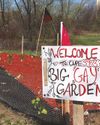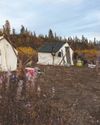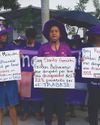Through the '60s, '70s, and '80s, the Canadian government took thousands of First Nations children from their families and placed them in white foster homes. I was one of them. Alienated from my language, culture, and community, I was taught to hate my people.
Decades later, I am still learning to heal.

One of the first memories I have of my grandmother happened on a sunny summer afternoon. She was looking after me that day. It was rare that I’d need a babysitter; the woman I referred to as my mom almost never went anywhere. Maybe there was a church meeting, perhaps for a committee planning their fall supper. I wasn’t even in school yet and didn’t ask questions. It was only later, when I was far older, that I began to ask.
“Let’s go outside. It’s time to pick the rhubarb and what’s left of the berries,” she told me. “Maybe I’ll make custard for you before your mom comes to pick you up. But don’t tell her – I know it’ll spoil your supper.” She grinned down at me. “Our secret?”
She ruffled my short hair and we headed outdoors into a slight Saskatchewan breeze. My grandma gave instructions, warning me not to pull out the roots of the rhubarb, “because it continues to grow even once it’s plucked.”
Years later, I’d remember those words.
I loved my grandma Lena, and she loved me. It didn’t matter that I was the only Brown grandchild, the only one who wasn’t biologically a part of the family. You would think the same love could be expected from the woman I lived with. The one I called my mom.
I am one of the many thousands of First Nations children who were taken at birth – ripped from the arms of Nikawiy (my birth mom) and placed in a white foster home. When it happened to me, they called it the ’60s Scoop – but it wasn’t just the ’60s. It began with the residential schools, with roots that date back to the early 1800s. Today, nearly half of all the children in Canada’s foster care system are Indigenous.
Bu hikaye Briarpatch dergisinin May/June 2018 sayısından alınmıştır.
Start your 7-day Magzter GOLD free trial to access thousands of curated premium stories, and 9,000+ magazines and newspapers.
Already a subscriber ? Giriş Yap
Bu hikaye Briarpatch dergisinin May/June 2018 sayısından alınmıştır.
Start your 7-day Magzter GOLD free trial to access thousands of curated premium stories, and 9,000+ magazines and newspapers.
Already a subscriber? Giriş Yap

PLATFORMS FOR PEOPLE, NOT PROFIT
Digital platforms boast that they’ve “democratized” cultural production. But what would truly democratic platforms look like in Canada?

ORGANIZING THROUGH LOSS IN THE HEART OF OIL COUNTRY
The story of climate justice organizing in Alberta, at the heart of the tarsands, is the story of a group of young activists learning what it means to lose, and keep on fighting

GROWING THE LABOUR MOVEMENT
How unions are using community gardens to engage members, nourish communities, and help strikers weather the picket line

A NEW ERA FOR OLD CROW
In the Yukon’s northernmost community, the Vuntut Gwitchin First Nation is reckoning with how to preserve their land and culture, amid a warming climate and an influx of tourists

“At Least Hookers Get Wages”
The risky business of sex work in the gig economy

The Literal – And Literary – Futures We Build
Briarpatch editor Saima Desai talks to two judges of our Writing in the Margins contest about Idle No More and MMIWG, ethical kinship, writing queer sex, and their forthcoming work.

The Cost Of A T-Shirt
In Honduras, women maquila workers are fighting back against the multinational garment companies that they say are endangering their health and safety.

Milking Prison Labour
Canada’s prison farms are being reopened. But when prisoners will be paid pennies a day, and the fruits of their labour will likely be exported for profit, there’s little to celebrate.

Bringing Back The Beat
In mainstream media, labour journalism has been replaced by financial reporting and business sections. But journalism students are raising the labour beat from the grave.

There's No Journalism On A Dead Planet
Corporate media owners are killing local newspapers – which is making it impossible for everyday people to understand the on-the-ground impacts of the climate crisis